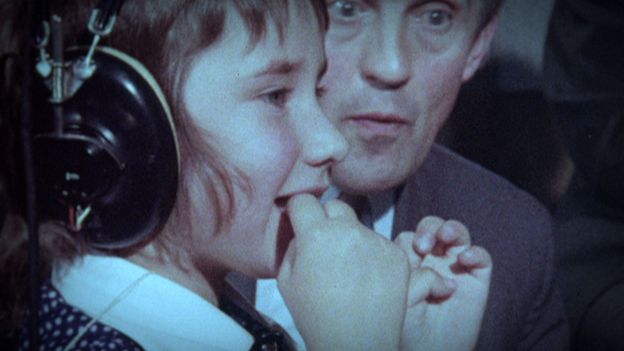See Hear: Looking behind the Curtain of Silence
- Published

In 1973 BBC Two's Horizon - which celebrates its 50th birthday this month - made its first documentary about deafness. Some forty years later it serves as a fascinating time capsule of attitudes to deafness at the time.
"In our loquacious society, the deaf are linguistic lepers," notes the commentary from the Curtain of Silence.
"Rarely can we be bothered to make that little extra effort in talking to them, trying to understand them. We give them the jobs we don't want. Having struggled into our world of speech, their opportunities are very limited."
But without teletext subtitling and in-vision signing 40 years ago, deaf audiences had little chance of knowing what was being said about them.
Today's viewers may be surprised at how little the programme even mentions sign language. It briefly features a group of deaf adults signing to each other, the voiceover stating: "For the deaf person who hasn't learned to speak, this is the easiest way of talking. It's slow, and few hearing people understand sign language."
The attitudes are strikingly dated by modern standards. But in the 1970s the show would have been seen by many as shedding an important spotlight on a relatively neglected part of society. The New Scientist magazine described it in 1973 as a show about "the world of those who are shut off from almost every normal social activity". There was also a strong belief that technology could cure deafness and its associated effects. Curtain of Silence reported on those technologies, while presenting a snapshot of deaf life back then.
A wide range of deaf and deafened people are featured. There's a young girl having her first hearing test, children learning to speak in a deaf school, and elderly people mourning the loss of birdsong. There's also a segment on young deaf adults just out of school using technology to try and improve their speech.
In this week's See Hear, we catch up with three of the original contributors and show them the 1973 programme they were in to get their response and memories of the time.
Claire Cummings, who featured as a four-year-old girl having a hearing test, vividly remembers how she would try to cheat in order to do better. "Sometimes [the audiologist] would lean forward and look up at me expectantly and that's when I'd respond. It's funny, as a direct result of that I was able to fake the test. I did it quite a lot. It's interesting to see from the clip that I was clearly lip-reading and I've done that all my life."
Lydia Handscomb: "The only thing I want to do is sign"
Lydia Handscomb was in her 20s when she appeared in the documentary. We see her using an experimental machine that transmitted vibrations through her fingertips to help her understand speech sounds, and so speak better.
Watching it four decades later, she regrets that she wasn't encouraged to sign by those around her. "As a deaf person the only thing I want to do is sign. I can't help it! It's important to be visual."
Alan Murray was a young man who took a different stance. He wanted to improve his speech in order to communicate better with hearing people, which he did by testing an experimental device that showed speech as a waveform. A female hearing assistant would say a phrase into the machine, and Alan would repeat it, attempting to emulate her intonation as closely as possible using the read-out - with mixed results.
Watching it back, Alan says it was others who encouraged him to do speech therapy. "People weren't ready for deaf people using sign language then, and I'd thought that, if my speech improved, that would mean I could fit in better with hearing people. But that wasn't the case - things didn't work out that way."
Prof Wendy McCracken, an expert in education of deaf people at the University of Manchester, recalls how attitudes have changed dramatically since the 1970s, when she was a trainee teacher. "There was a belief, even in the linguistics community, that sign language wasn't a language.
"We didn't know how to teach it. I think there was a real fear of deaf adults at the time. We didn't see them as partners in education. There wasn't any kind of signed curriculum, so they were really worried that if you in any way used gesture you would stop children talking.
"Now we have a clear recognition that signed language is a language."
What can we learn from watching the Curtain of Silence?
Claire Cummings thinks the programme captures a mood prevalent at the time: "It was very interesting to see the optimism back then where they believed anything was possible. Now we know differently. It's not like that now. It was the typical 1960s and '70s optimism. They believed in science. They believed that education and science would solve everything."
Accessibility has changed over the years too. While the first programme may have been more about - rather than for - deaf people, today there is much better access to the media and they are part of the conversation. Many would say they are no longer behind that curtain of silence described by the long-running documentary series.
See Hear's Curtain of Silence retrospective is showing at 10.30am on Wednesday 7 May on BBC Two, and will be available on iPlayer soon after
The original Curtain of Silence documentary will be included in Horizon's anniversary collection, due to be available online from 22 May
Email us at [email protected] with your stories and comments, like our Facebook page and enjoy watching our programme.
Follow @BBCOuch on Twitter and on Facebook, and listen to our monthly talk show